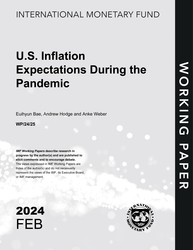
U.S. Inflation Expectations During the Pandemic
U.S. Inflation Expectations During the Pandemic
READ MORE...
Volume/Issue:
Volume 2024
Issue 025
Publication date: February 2024
ISBN: 9798400266867
$20.00
Add to Cart by clicking price of the language and format you'd like to purchase
Available Languages and Formats
| English |
Prices in red indicate formats that are not yet available but are forthcoming.
Topics covered in this book
This title contains information about the following subjects.
Click on a subject if you would like to see other titles with the same subjects.
Inflation , Economics- Macroeconomics , Economics / General , Inflation Expectations , Learning , Forecasting , inflation expectation , consumer expectation , surge of inflation , price markup shock , monetary policy response , Inflation , Rational expectations , Income , Dynamic stochastic general equilibrium models , Global
Summary
This paper studies how and why inflation expectations have changed since the emergence of Covid-19. Using micro-level data from the University of Michigan Survey of Consumers, we show that the distribution of consumer expectations at one-year and five-ten year horizons has widened since the surge of inflation during 2021, along with the mean. Persistently high and heterogeneous expectations of consumers with less education and lower income are mainly responsible. A simple model of adaptive learning is able to mimic the change in inflation expectations over time for different demographic groups. The inflation expectations of low income and female consumers are consistent with using less complex forecasting models and are more backward-looking. A medium-scale DSGE model with adaptive learning, estimated during 1965-2022, has a time-varying solution that produces lower forecast errors for inflation than a variant with rational expectations. The estimated model interprets the surge of inflation in 2021 mainly as the result of a price markup shock, which is more persistent and requires a larger and more persistent monetary policy response than under rational expectations.
Copyright © 2010 - 2025
Powered by:
AIDC



